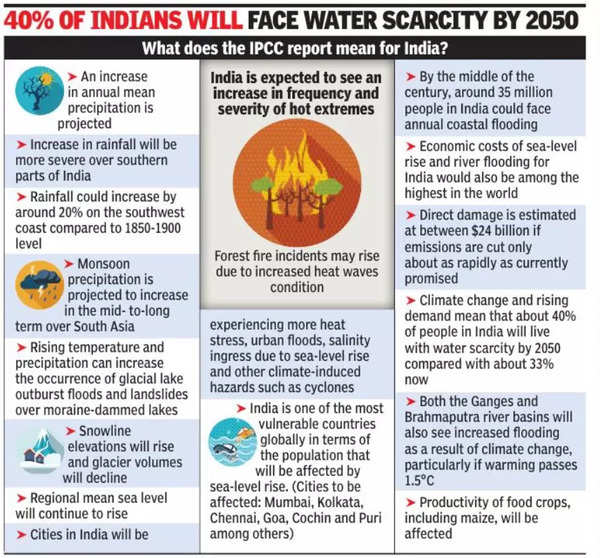IPCC AR6 Synthesis Report | 21 Mar 2023
Prelims: IPCC, Climate Change, Global Warming, GHG, CCH, Maladaptation
Mains: IPCC AR6 Synthesis Report.
Why in News?
According to the 4th and final installment Intergovernmental Panel on Climate Change (IPCC) under the Sixth Assessment Report (AR6), there is increased evidence of maladaptation in various sectors and regions.
- The Synthesis Report integrates the main findings of the AR6 cycle based on contributions from the three Working Groups, and the three Special Reports.
What are the Key Findings?
- Unprecedented Global Warming:
- Human-induced global warming of 1.1 degrees Celsius has spurred changes to the Earth’s climate that are unprecedented in recent human history.
- Already, with 1.1 degrees Celsius of global temperature rise, changes to the climate system that are unparalleled over centuries to millennia are now occurring in every region of the world, from rising sea levels to more extreme weather events to rapidly disappearing sea ice.
- More Widespread Climate Impact:
- Climate impacts on people and ecosystems are more widespread and severe than expected, and future risks will escalate rapidly with every fraction of a degree of warming.
- Adaptation Measures:
- Adaptation measures can effectively build resilience, but more finance is needed to scale solutions.
- Climate policies in at least 170 countries now consider adaptation, but in many nations, these efforts have yet to progress from planning to implementation. Measures to build resilience are still largely small-scale, reactive and incremental, with most focusing on immediate impacts or near-term risks.
- Current global financial flows for adaptation are insufficient for, and constrain implementation of, adaptation options, especially in developing countries.
- Global Temperature may Surpass 1.5 degrees Celsius:
- There is a more than 50% chance that global temperature rise will reach or surpass 1.5 degrees Celsius between 2021 and 2040 across studied scenarios, and under a high-emissions pathway, specifically, the world may hit this threshold even sooner — between 2018 and 2037.
- Maladaptation:
- India has many such examples of maladaptation, resulting in vulnerable communities becoming more helpless to the impacts of climate change rather than being able to adapt to them.
- Maladaptation is defined as the changes in natural or human systems that inadvertently increase vulnerability to climate stimuli.
- It is an adaptation measure that does not succeed in reducing vulnerability but increases it instead.
- Odisha has one of the most dynamic coasts in the country, with sea levels rising at a rate more than the average for the rest of the country. It is also the most cyclone-prone state in India.
- India has many such examples of maladaptation, resulting in vulnerable communities becoming more helpless to the impacts of climate change rather than being able to adapt to them.
What are the Recommendations?
- The world must rapidly shift away from burning fossil fuels — the number one cause of the climate crisis.
- A mix of strategies can help avoid locking in the carbon emissions, including retiring existing fossil fuel infrastructure, canceling new projects, retrofitting fossil-fueled power plants with carbon capture and storage (CCS) technologies and scaling up renewable energy sources like solar and wind.
- There is a need for urgent, systemwide transformations to secure a net-zero, climate-resilient future.
- While fossil fuels are the number one source of GHG emissions, deep emission cuts are necessary across all of society to combat the climate crisis.
What is IPCC?
- The IPCC is the UN body for assessing the science related to climate change.
- It was set up in 1988 by the World Meteorological Organization and United Nations Environment Programme to provide policymakers with regular assessments of the scientific basis of climate change, its impacts and future risks, and options for adaptation and mitigation.


